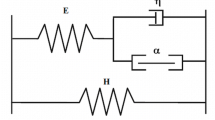A procedure for a two-level modeling of deformation of skeletal muscles is offered. Based on a phenomenological model of an individual muscle fiber, consisting of a viscous, a contractive, and two nonlinearly elastic elements (the first level), various means for describing a skeletal muscle as a whole (the second, macroscopic level) are considered. A method for identification of a muscle model by utilizing experimental elongation diagrams in a passive state and in isotonic contraction is put forward. The results of a biomechanical analysis are compared with known experimental data for the isotonic and isometric activation regimes of tailor’s muscle of a frog. It is established that preferable is the description of a muscle that takes into account the different lengths of muscle fibers and their twist.








Similar content being viewed by others
References
Yu. M. Pleskachevskii, S. V. Shil’ko, and K. K. Bondarenko, “The role of biomechanics in elite sports,” in: Trans. 4th Belarus Congr. Theor. Appl. Mech. “Mekhanika-2009”, December, 22-24, 2009, Minsk (2009), pp. 79–91.
Yu. M. Pleskachevsky, S. V. Shilko, and S. V. Stelmakh, “Evolution and structural levels of materials: adaptive composites,” J. Wave-Mater. Interact., 14, Nos. 1-2, 49–58 (1999).
P. Těšinova (ed.), Analysis of Natural and Man-Made Materials, in: Tech, - <http://www.intechopen.com/articles/show/ title/adaptive-composite-materials-bionics-principles-abnormal-elasticity-moving-interfaces. P. 497526 > .
D. A. Chernous and S. V. Shil’ko, “A phenomenological model of the muscle as an active composite,” Mech. Compos. Mater., 44, No. 6, 641–648 (2008).
A. E. Aliev, J. Oh, M. E. Kozlov, et al., “Giant-stroke, superelastic carbon nanotube aerogel muscles,” Science, 323, No. 5921, 1575–1578 (2009).
J. Foroughi, G. M. Spinks, and G. G. Wallace, “Torsional carbon nanotube artificial muscles,” Science, 334, No. 6055, 494–497 (2010).
A. V. Hill, First and Last Experiments in Muscle Mechanics, Cambridge (1970).
A. G. Fel’dman, Central and Reflex Control Mechanisms of Motion [in Russian], Nauka, Moscow (1979).
V. I. Dereshchevskii, Mathematical Models of Muscle Contraction [in Russian], Nauka, Moscow (1977).
D. A. Chernous, “Modeling of contractive activity of the muscle tissue,” Russ. J. Biomech., 10, No. 3, 51-62 (2006).
Lee Eun-J., V. Joumaa, and W. Herzog, “New insights into the passive force enhancement in skeletal muscles,” J. Biomech., 40, No. 5, 719–727 (2007).
E. M. H. Bosboom et al., “Passive transverse mechanical properties of skeletal muscle under in vivo compression,” J. Biomech., 34, 1365–1368 (2001).
P. I. Usik, Continual mechanochemical model of muscular tissue,” Prikl. Matem. Mekh., 37, No. 3, 448–458 (1973).
A. M. Gordon, A. F. Huxley, and F. J. Julian, “The variation in isometric tension with sarcomere length in vertebrate muscle fibers,” J. Physiol., 184, No. 1, 170–192 (1966).
V. I. Dubrovskii and V. N. Fedorova, Biomechanics [in Russian], VLADOS-PRESS, Moscow (2003).
D. A. Chernous and S. V. Shil’ko, “Description of the tension diagram of a twisted filament,” Plast. Massy, No. 7, 41–44 (2006).
J. Davisa, K. R. Kaufmanb, and R. L. Liebera, “Correlation between active and passive isometric force and intramuscular pressure in the isolated rabbit tibialis anterior muscle,” J. Biomech., 36, No. 4, 505–512 (2003).
A. Moretsky, K. Fidelyus, and K. Kendzior, “Investigation and simulation of the biomechanical properties of skeletal muscles,” Mekh. Polim., No. 4, 629–633 (1975).
Acknowlegments
This investigation was performed within the framework of project 5.30.01 of the State Program of Scientific Research of Belarus Republic “Convergence” (“Interdisciplinary Scientific Research and New Emerging Technologies as a Basis for a Stable Innovative Development”).
Author information
Authors and Affiliations
Corresponding author
Additional information
Translated from Mekhanika Kompozitnykh Materialov, Vol. 48, No. 3, pp. 485-502, May-June, 2012.
Rights and permissions
About this article
Cite this article
Shil’ko, S.V., Chernous, D.A. & Pleskachevskii, Y.M. Nonlinear deformation of skeletal muscles in a passive state and in isotonic contraction. Mech Compos Mater 48, 331–342 (2012). https://doi.org/10.1007/s11029-012-9280-8
Received:
Published:
Issue Date:
DOI: https://doi.org/10.1007/s11029-012-9280-8




